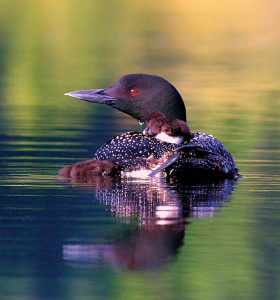
By Karen M. Bourque
Just about a mile as the crow (or cardinal, or chickadee) flies from the Connecticut River’s western bank in Norwich, Vermont, sits a nondescript building that houses one of the most effective wildlife conservation organizations in the Northeast that
you’ve probably never heard of: the Vermont Center for Ecostudies (VCE).  There is no visitor’s center, no gallery of specimens to pore over, no lecture hall for attending natural history presentations. Instead, you’ll find ornithologists, herpetologists, pollinator specialists, outreach naturalists, and even a software engineer stuffed into offices and cubes, busily carrying out critical work in a race to conserve wildlife in the Western Hemisphere. They study, tweet, blog, write, lecture, live, breathe, and photograph nature. They even host a monthly radio show on Vermont Public radio called Outdoor Radio, and offer a lecture series aptly named Suds & Science that draws science fans from both sides of the river to gather at a local tavern for lively conversation and craft beverages.
There is no visitor’s center, no gallery of specimens to pore over, no lecture hall for attending natural history presentations. Instead, you’ll find ornithologists, herpetologists, pollinator specialists, outreach naturalists, and even a software engineer stuffed into offices and cubes, busily carrying out critical work in a race to conserve wildlife in the Western Hemisphere. They study, tweet, blog, write, lecture, live, breathe, and photograph nature. They even host a monthly radio show on Vermont Public radio called Outdoor Radio, and offer a lecture series aptly named Suds & Science that draws science fans from both sides of the river to gather at a local tavern for lively conversation and craft beverages.
What sets VCE apart from other research organizations is that their scientists engage—and in fact, depend on—the public for the success of their field research and wildlife monitoring projects. Projects like one of the continent’s longest-running studies of forest bird population trends, and saving the Common Loon from imminent extirpation in Vermont, for example. VCE’s army of volunteer citizen scientists—people like you— pour their hearts and souls (and collectively, a huge amount of time and energy) into a range of activities crucial to understanding the state of our natural world. They identify and count bird species from deep river valleys to the summits of the Northeast’s highest mountains; monitor and help rescue loons; evaluate vernal pool ecosystems; and submit thousands of observations of the myriad life forms along the Connecticut River watershed from Canada to Connecticut and beyond to a global biodiversity database.
And, they have a lot of fun along the way.
This collaboration of scientists and volunteers has racked up an impressive list of accomplishments, including:
- When VCE, with help from citizen scientists, discovered that bumblebees were vanishing from Vermont, they used volunteer collected scientific data that resulted in four bees being formally protected under the state endangered species law.
- When conservationists across the Northeast wanted to map and protect vernal pools, they turned to VCE for leadership on a citizen science-fueled project that now reaches from Virginia to Nova Scotia.
- VCE biologists published population estimates and state specific trends of Bicknell’s Thrush, a rare and vulnerable migratory bird species, using 10 years of data collected by VCE’s Mountain Birdwatch program volunteers.

These are but a few of many examples. Learn more about VCE’s work and how can you get involved at VTEcostudies.org, and follow them on social media (@vtecostudies). You don’t have to live in Vermont or have a background in science to make a real contribution to wildlife conservation as a VCE volunteer. After all, as VCE Executive Director, Chris Rimmer, often states: “Conservation is as much about people as it is about wildlife.”

